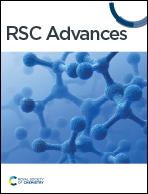Synthesis of novel phthalazine-based derivatives with potent cytotoxicity against HCT-116 cells through apoptosis and VEGFR2 inhibition†
Abstract
The parent ethyl 3-(4-benzyl-1-oxophthalazin-2(1H)-yl) propanoate (3) has 25 compounds. Their respective mono, dipeptides and hydrazones derivatives were produced by chemoselective N-alkylation via addition reaction of 4-benzylphthalazin-1(2H)-one (2) with ethyl acrylate and anhydrous potassium carbonate to give ethyl 3-(4-benzyl-1-oxophthalazin-2(1H)-yl) propanoate (3). The ester 3 was hydrazinolyzed to give the corresponding hydrazide 3-(4-benzyl-1-oxophthalazin-2(1H)-yl) propanehydrazide (5), then azide 6 coupled with amino acid ester hydrochloride and/or amines to afford several parent esters 8a–c, then a series of hydrazinolyzed reactions occurred to give corresponding hydrazides 9a–c. The hydrazide 9a was subjected to the azide coupling procedure, which resulted in the formation of various dipeptides. Subsequently, it was condensed with various aldehydes to yield hydrazone derivatives 13a–d. Interestingly, compounds 9c, 12b, and 13c exhibited potent cytotoxicity with IC50 values of 1.58, 0.32 and 0.64 μM compared to sorafenib (IC50 = 2.93 μM). Compound 12b exhibited potent VEGFR2 inhibition by 95.2% with an IC50 value of 17.8 μM compared to sorafenib (94.7% and IC50 of 32.1 μM). For apoptosis activity, 12b-treatment induced apoptosis in HCT-116 cells by 21.7-fold, arresting the cell proliferation at S-phase. Finally, it formed a good binding affinity towards VEGFR2 protein with a binding energy of −10.66 kcal mol−1, and it formed binding interactions with the key interactive amino acids.



 Please wait while we load your content...
Please wait while we load your content...